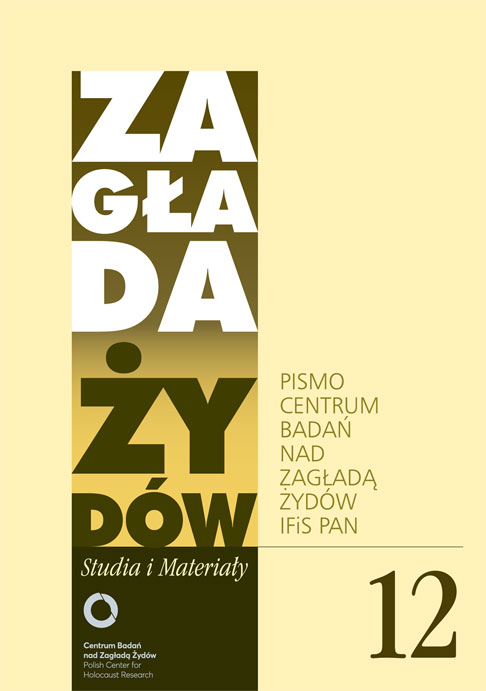Death of the Antiquarian on Chłodna Street
Zagłada Żydów. Studia i Materiały, No. 12 (2016), Pages: 262-278
Submission Date: 2020-10-19Publication Date: 2016-11-30
 https://doi.org/10.32927/ZZSiM.416
https://doi.org/10.32927/ZZSiM.416
Abstract
The great liquidation campaign in the Warsaw ghetto began on 22 July 1942. Throughout its course, more than 250,000 ghetto residents were deported to the death center in Treblinka. A day before, in order to inspire an atmosphere of terror and resignation, the Germans organized a liquidation of well-known representatives of the ghetto intelligentsia. The murder of a Jewish antiquarian in an apartment on Chłodna Street and Professor Franciszek Raszeja, a famous Polish doctor, called from the ‘Aryan’ side, echoed far and wide on both sides of the wall. In survivor testimonies and post-war memories as well as in studies produced on their basis it was assumed that the murdered antiquarian was Abe Gutnajer, the most famous pre-war Warsaw art dealer and the owner of the prestigious ‘Salon Sztuki’ antique art store on Mazowiecka Street. Aside from Gutnajer and Raszeja, the Germans purportedly murdered Abe’s entire family and people who accompanied Raszeja during the surgery. Nawojka Cieślińska- Lobkowicz, who had studied the history of the occupation-period art market for years, argues that the victim of that crime, committed probably in the morning of 22 July 1942, was not Abe Gutnajer but his elder brother Bernard, who before the war owned an antique store on Wierzbowa Street. He was killed along with Albert Schulberg, an antiquarian from Lvov, whose activity in the Warsaw ghetto consisted in, for instance, purchasing works of art and antiques for Zofia Leśniewska’s occupation-period antique art store, which he did with the Germans’ permission. Bernard Gutnajer was the one who called Professor Raszeja for a consultation to his apartment on Chłodna Street.
License
Copyright (c) 2016 Author&"Holocaust Studies and Materials"

This work is licensed under a Creative Commons Attribution 4.0 International License.
https://creativecommons.org/licenses/by/4.0
The journal is published under the Diamond Open Access Standard, CC-BY-4.0 Deed - Attribution 4.0 International - Creative Commons
Most read articles by the same author(s)
- Nawojka Cieślińska-Lobkowicz, Traces of Unknown Pre-war Jewish Collectors and Owners of Works of Art , Zagłada Żydów. Studia i Materiały: No. 17 (2021)
- Nawojka Cieślińska-Lobkowicz, Polish. Jewish. ‘Post-Jewish’. Nazi Looting of Works of Art and Restitution Issues in Poland 1945‒2020 , Zagłada Żydów. Studia i Materiały: No. 16 (2020)
- Nawojka Cieślińska-Lobkowicz, The new Holocaust Museum in Amsterdam , Zagłada Żydów. Studia i Materiały: No. 20 (2024)
- Nawojka Cieślińska-Lobkowicz, Predator. The Looting Activity of Pieter Nicolaas Menten (1899–1987) , Zagłada Żydów. Studia i Materiały: No. Holocaust Studies and Materials (2017)
- Nawojka Cieślińska-Lobkowicz, Jewish Biblia Pauperum , Zagłada Żydów. Studia i Materiały: No. 11 (2015)
- Nawojka Cieślińska-Lobkowicz, Professional Looter. On the looting activity of Pieter Nicolaas Menten (1899–1987) , Zagłada Żydów. Studia i Materiały: No. 11 (2015)
- Nawojka Cieślińska-Lobkowicz, Habent Sua Fata Libelli. Occupation-period art market in Warsaw and Jewish property , Zagłada Żydów. Studia i Materiały: No. 10 (2014)
- Nawojka Cieślińska-Lobkowicz, Losy mienia kulturalnego polskich Żydów w okresie okupacji hitlerowskiej i w pierwszych latach powojennych , Zagłada Żydów. Studia i Materiały: No. 6 (2010)
- Nawojka Cieślińska-Lobkowicz, World War II Tragedy Memorial Museum , Zagłada Żydów. Studia i Materiały: No. 13 (2017)
- Nawojka Cieślińska-Lobkowicz, On the “What We Were Unable to Shout Out to the World” Exhibition at the Jewish Historical Institute in Warsaw , Zagłada Żydów. Studia i Materiały: No. 14 (2018)
Similar Articles
- Nawojka Cieślińska-Lobkowicz, Habent Sua Fata Libelli. Occupation-period art market in Warsaw and Jewish property , Zagłada Żydów. Studia i Materiały: No. 10 (2014)
- Gabriel Finder, The Trial of Shepsl Rotholc and the Politics of Retribution in the Aftermath of the Holocaust , Zagłada Żydów. Studia i Materiały: No. 2 (2006)
- Gabriel Finder, Bernard Mark, the Uprising in the Warsaw Ghetto, and Jürgen Stroop’s Trial , Zagłada Żydów. Studia i Materiały: No. 13 (2017)
- Jacek Leociak, Understanding the Holocaust. A Task for Generations , Zagłada Żydów. Studia i Materiały: 2008: Holocaust Studies and Materials
- Karolina Panz, The Destruction of shtetl Grice , Zagłada Żydów. Studia i Materiały: No. 3 (2007)
- Jacek Leociak, Anniversaries of the Warsaw Ghetto Uprising in public discourse (with special reference to the years 1943–1944, 1968 and 2023) , Zagłada Żydów. Studia i Materiały: No. 19 (2023)
- Dariusz Libionka, Adam Kopciowski, The Life and the Holocaust in Hrubieszów in the Eyes of a Young Woman from Warsaw , Zagłada Żydów. Studia i Materiały: No. 3 (2007)
- Nawojka Cieślińska-Lobkowicz, Predator. The Looting Activity of Pieter Nicolaas Menten (1899–1987) , Zagłada Żydów. Studia i Materiały: No. Holocaust Studies and Materials (2017)
- Irmina Gadowska, Conditions of artistic activity in the Łódź ghetto 1940–1944 in the light of sources: administration documents, recollections and witness testimonies , Zagłada Żydów. Studia i Materiały: No. 16 (2020)
- Nawojka Cieślińska-Lobkowicz, Professional Looter. On the looting activity of Pieter Nicolaas Menten (1899–1987) , Zagłada Żydów. Studia i Materiały: No. 11 (2015)
1 2 3 4 5 6 7 8 9 10 11 12 13 14 15 16 17 18 19 20 21 22 23 24 25 26 27 28 29 30 31 32 33 34 35 36 37 38 39 40 41 42 43 44 45 46 47 48 49 50 > >>
You may also start an advanced similarity search for this article.
 English
English
 Język Polski
Język Polski




